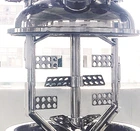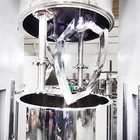Filling Thick Products: Challenges and Technological Solutions
As highlighted in our article “Top 5 Mistakes to Avoid When Buying a Filling Machine: Technical Mistakes,” choosing the right filling equipment is complex and highly dependent on the nature of the product being handled. This is particularly true for thick, viscous products, where the technical demands differ greatly from those for thin, free-flowing liquids.
Due to their consistency, thick products present challenges in flow behavior, air handling, hygiene, and container compatibility—areas where standard filling equipment often fails. Investing in the wrong machine can lead to issues like product waste, high maintenance costs, and extended downtime. Ultimately, this affects both operational efficiency and profitability.
In this article, we will focus specifically on the technical solutions to these challenges. For a more comprehensive perspective, including financial and supplier-related considerations, refer to our full series: Top 5 Mistakes to Avoid When Buying a Filling Machine.
Challenges in Filling Thick Products
Before diving into the solutions, it’s important to understand the key problems that thick, viscous products cause during filling:
- Viscosity and Flow Behavior
- Problem: Thick products resist gravity and do not flow easily through standard filling systems.
- Result: Inconsistent fills, reduced production speed, increased wear, and clogging in equipment.
- Air Entrapment
- Problem: Dense materials often trap air, leading to foam, bubbles, or voids in the final packaging.
- Result: Underfilled containers, poor presentation, and even potential spoilage.
- Residue and Waste
- Problem: High-viscosity materials stick to tank walls, filling nozzles, and internal piping.
- Result: Product loss, frequent cleaning needs, and contamination risk.
- Heat Sensitivity
- Problem: Some viscous products (e.g., creams, sauces, or pharmaceuticals) degrade when heated.
- Result: Loss of product if the system isn’t equipped with cooling.
- Hygiene and Cleanability
- Problem: Viscous products increase the risk of bacterial growth due to residue buildup.
- Result: More frequent cleaning cycles and downtime, especially in regulated industries.
- Container Compatibility
- Problem: The pressure or force needed to fill thick substances can deform lightweight packaging.
- Result: Packaging failure, label misalignment, or spilling.
Now that we’ve outlined these challenges, let’s explore how technology can address them effectively.
Technological Solutions for Filling Thick Products
Each challenge can be mitigated with specific technologies designed to improve efficiency, accuracy, and hygiene. Below is a detailed look at the most relevant solutions:
- Positive Displacement (PD) Pumps
- How it works: PD pumps use mechanical force—via pistons, lobes, or gears—to push a fixed volume of product through the system.
- Benefits:
- Excellent for high-viscosity fluids (e.g., peanut butter, lotions).
- Maintains consistent volume regardless of thickness.
- Can handle small particulates without clogging.
- Use Case: Ideal for precise dosing in cosmetics and food industries.
- Servo-Driven Fillers
- How it works: These use programmable electric servo motors (precise, computer-controlled motors) to control the filling piston or pump.
- Benefits:
- Adjustable fill speed and volume.
- Reduces splashing, foaming, and air entrapment.
- Smooth operation for heat-sensitive or shear-sensitive products (products that break down if handled roughly).
- Use Case: Perfect for high-end, low-tolerance applications requiring accuracy.
- Heated Fill Systems
- How it works: Heats the product slightly to reduce viscosity during the fill cycle.
- Benefits:
- Easier pumping and faster flow rates.
- More consistent fill weights.
- Caution: Only suitable for heat-tolerant materials (e.g., wax-based creams or sauces).
- Use Case: Often used in candle-making or hot-fill sauces.
- Vacuum Filling
- How it works: Creates a vacuum inside the container to pull product in naturally.
- Benefits:
- Eliminates trapped air and bubbles.
- Ensures accurate fill levels in rigid containers.
- Use Case: Excellent for thick products in glass jars (e.g., jam, paste).
- Auger Fillers
- How it works: Uses a rotating screw (auger) to push product into the container.
- Benefits:
- Handles powders, pastes, and semi-solids.
- Consistent and adjustable fill volumes.
- Use Case: Often used for products like nut butters, mashed food, or powdered mixtures.
- Hopper Agitation and Scrapers
- Purpose: Keeps product in motion inside the hopper to prevent separation, settling, or clogging.
- Benefits:
- Ensures even consistency during the entire fill process.
- Reduces dead zones where product can harden or cool.
- Use Case: Essential for chunky sauces, thick body scrubs, or spreads.
- No-Drip and Clean-Cut Nozzles
- How it works: Engineered nozzles that “cut off” the flow cleanly at the end of each fill.
- Benefits:
- Prevents stringing and dripping.
- Reduces mess, cleanup time, and product waste.
- Use Case: Common in both pharmaceutical and food production.
- CIP (Clean-in-Place) Systems
- Purpose: Enables automated internal cleaning of the machine without disassembly. This is essential for maintaining hygiene and minimizing downtime. (For a deeper dive, see our article: “Never Overlook Compliance & Safety.”)
- Benefits:
- Reduces downtime between batches.
- Ensures consistent and thorough cleaning.
- Supports food safety and GMP (Good Manufacturing Practices) compliance.
- Use Case: Especially critical in tightly regulated industries like dairy, pharmaceuticals, and infant food production, where hygiene standards are non-negotiable.
Summary Table
|
Challenge |
Technological Solution |
|
High viscosity |
Positive displacement pumps, heated systems |
|
Air entrapment |
Vacuum fillers, slower fill cycles, air release vents |
|
Product residue |
Scrapers, sloped surfaces, CIP systems |
|
Heat sensitivity |
Servo-driven fillers, low-shear systems |
|
Container deformation |
Pressure sensors, adaptable nozzles |
|
Hygiene/cleanability |
CIP/SIP systems, sanitary tubing and valves |
Evaluate Before You Invest
While these technologies offer clear benefits, each added feature increases cost and complexity. Before purchasing a filling machine, consult with your production, maintenance, and quality assurance teams to determine:
- Which challenges are critical for your product?
- Which technologies are must-haves, and which can be added later?
- What is your expected production volume and growth?
Buying more than you currently need can lead to unnecessary investment. However, buying too little could hurt you in the long run. It's worth considering modular systems or machines that allow upgrades later.
Conclusion: Think Long Term and Take Action
In today’s rapidly evolving manufacturing environment, new filling technologies constantly emerge to improve efficiency, reduce waste, and support compliance. Don’t hesitate to speak with your supplier about the flexibility and upgradeability of their machines.
A supplier willing to work with your future needs is not just selling a machine—they’re providing a scalable solution. That’s good for them, and even better for you.
Have questions about your specific product or filling challenges? Contact our team—we’re here to help you find the right solution that grows with your business.














































































































